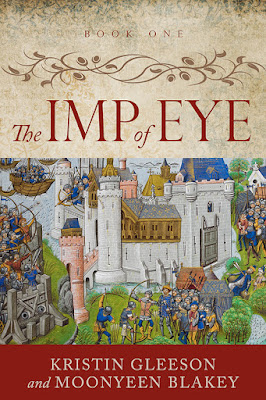While the storm clouds of the Wars of the Roses gather in fifteenth century London, Barnabas, a streetwise thirteen year-old orphan, dreams of sailing away to foreign countries. His mistress, Margery Jourdemayne, the Witch of Eye, and his guardian, CanonThomas Southwell, plot to use his clairvoyant talents to further their ambitions. Vain and ambitious Eleanor, Duchess of Gloucester, turns to the Witch of Eye to conceive a child to secure her position as the wife of the heir to the throne, but her husband’s enemies are determined to use her actions to bring about his downfall...
I didn’t set out to write The Imp of Eye. It began its life as a
tale my dear friend and writer, Moonyeen Blakey created. Moon had
become interested in the story of the witch, Margery Jourdemayne, in the course
of her research for a previous book she’d started writing about and she decided
she wanted to fashion a story around a young boy, whom she called Barnabas, in
Jourdemayne’s household. She discussed the storyline with me several times and
I followed its development. She managed
to complete a first draft of it when she fell ill with a second bought of
cancer. This time, unfortunately, she was unable to beat it and she died in
March 2014. Before she died, she asked me to take on the novel and do
with it what I thought best.
It was a task I took on with mixed feelings
because in some ways it felt like treading in her shadow, but I wanted to
honour her creation and the effort she put into writing it in order to make it
a success for her. I read through the
manuscript and also all the material she’d gathered for her research.
Besides
my general knowledge of Medieval history and the 15th century
England, I read book on Medieval feasting like, Food & Feast in Medieval England, and also Life in the Middle Ages, Growing Up in Medieval London, as well as
books on Medieval women. What was the
most fun was using a replica detailed street map of London from the early 16th
century.
The most compelling piece I read, however,
was a journal article published in Journal
of Medieval History by Jessica Freeman entitled, ‘Sorcery at court and
manor: Margery Jourdemayne, the witch of Eye next Westminster.’ It told not only Margery’s story, but also
the story of Eleanor, Duchess of Gloucester. As a historian of women’s history
I found her very intriguing as well as Barnabas. Both of them, one fictional
and one not, in my view were victims of royal intrigue at court. What great material for a novel. Though
Eleanor was in Moon’s story, I wanted to give her a prominent role, alongside of
Barnabas.
As I read more sources I came to the view
that Eleanor’s arrest and trial for witchcraft and treason was very significant
in more ways than one. Her importance lay not only in the fact she was she a
tool for her husband’s enemies to use her to bring down her husband, Henry VI’s
heir and uncle, but also that they charged her, a royal duchess and peeress of
the realm, with witchcraft and treason. This had never happened before. The
fact that the trial proceeded and a judgement was made (though she was able to
refute the charge of treason) the way was paved for Henry VIII to levy charges
of treason and witchcraft against peers of the realm.
After working through the draft and
bringing these two characters to prominence I found that the story had taken me
up and along with Moon who seemed to sit on my shoulders as I wrote, it all was
directed as a joint effort. When the writing was finishing I found that I
couldn’t let Barnabas go. As a fourteen year old his story only seemed to
begin. I found new stories emerging for
him and so The Renaissance Sojourner Series was born. Knowing how much Moon loved Barnabas, I’m
certain she would approve.
Kristin Gleeson
# # #
About the Author
Originally from Philadelphia, Kristin
Gleeson lives in Ireland, in the West Cork Gaeltacht, where she teaches art
classes, plays harp, sings in an Irish choir and runs two book clubs for the
village library. She holds a Masters in Library Science and a Ph.D. in history, and for a
time was an administrator of a national archives, library and museum in
America. She has also worked as a public librarian in America and Ireland. Find out more at Kristin's website www.kristingleeson.com and find her on Facebook and Twitter @krisgleeson.




























